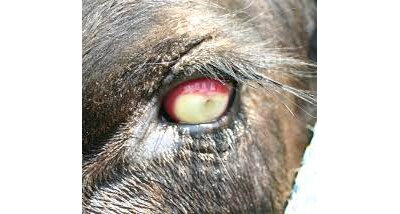
IBK-Infectious Bovine Keratoconjunctivitis. Pink Eye is a painful and highly infectious eye disease of cattle which if not treated adequately can result in large numbers of animals affected and temporary or permanent blindness.
Causes.
The primary cause of pinkeye is bacteria known as Moraxella bovis, but other bacteria and viruses are often involved. The high risk period is late spring and summer. Pinkeye occurs predominantly in young cattle but cattle of any age can be affected.
Risk Factors.
Risk factors for Pink Eye include wind, dust, flies, stalky vegetation, and high stocking rate. Damage to the surface of the eye (scratching from grass seed heads) and ultraviolet radiation can predispose the eye to infection. The bacteria can be present on flies and grass seed heads. Forcing cattle to graze low in stalky feed is a high risk for pinkeye.
Clinical Signs.
The first signs of Pink Eye are weepy eyes. A central ulcer soon develops followed by cloudiness in the eye. If left untreated this ulcer enlarges and pus forms in the eye leading to increased pressure and eventual rupture of the eye in extreme cases. Pinkeye can cause prolonged and serious pain.
The Impact.
Pink Eye is an animal welfare issue causing prolonged and serious pain.
Consequences of Pink Eye include:
The disease may exist for 3-5 weeks in some individuals, with a peak in a mob of about 3-4 weeks.
Despite this many farmers believe Pink Eye is not a significant problem and many choose to not treat or prevent the disease and let the disease take its course.
Diagnosis is made by clinical signs and in some cases swabs obtained from infected eyes. A veterinarian examination is required to confirm Pink Eye.
Management and Control.
Quick action is required to prevent the spread of Pink Eye. Affected animals should be immediately removed from the mob for treatment. Infected animals must remain separated.
Antibiotic treatments are commonly used to treat Pink Eye. These will be prescribed by your vet who will also show you how to treat animals and decide if the whole mob should be treated.
Surgery to either protect the eye with the third eyelid or close the eye completely is possible.
Prevention.
A vaccine is available which is most effective if given 2-3 weeks prior to the expected Pink Eye season. It is less effective if given once the Pink Eye has started. Grazing management, stocking rate, and animal wellness are all very important aspects of Pink Eye prevention.